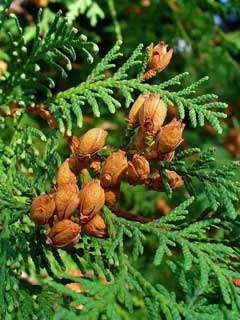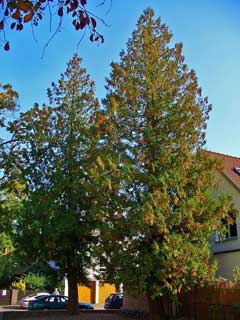 |
|
http://commons.wikimedia.org/wiki/User:Llez |
 |
| http://commons.wikimedia.org/wiki/User:Llez |
Translate this page:
Summary
Bloom Color: Yellow. Main Bloom Time: Early spring, Late spring, Mid spring. Form: Pyramidal.
Physical Characteristics

 Thuja occidentalis is an evergreen Tree growing to 15 m (49ft) by 5 m (16ft) at a slow rate.
Thuja occidentalis is an evergreen Tree growing to 15 m (49ft) by 5 m (16ft) at a slow rate.
See above for USDA hardiness. It is hardy to UK zone 2. It is in leaf all year, in flower from April to May, and the seeds ripen from September to October. The species is monoecious (individual flowers are either male or female, but both sexes can be found on the same plant) and is pollinated by Wind.
Suitable for: light (sandy), medium (loamy) and heavy (clay) soils and can grow in heavy clay soil. Suitable pH: mildly acid, neutral and basic (mildly alkaline) soils and can grow in very alkaline soils.
It can grow in semi-shade (light woodland) or no shade. It prefers moist or wet soil.
UK Hardiness Map
US Hardiness Map
Synonyms
Cupressus arborvitae O.Targ.Tozz. Juniperus ericoides Mast. Retinispora devriesiana Mast.
Plant Habitats
Woodland Garden Canopy;
Edible Uses
Edible Parts: Shoots Stem
Edible Uses: Tea
Pith of young shoots - cooked[105]. It can be added to soups[177]. Pleasantly sweet, the pith was used as the basis of the soup according to one report[183]. Inner bark - cooked. It is only used in times of emergency or scarcity[213]. The inner bark can be dried and ground into a powder, then used with wheat or other cereals in making bread, biscuits etc. The leafy branchlets are used as a tea substitute[159, 177, 257] but are probably best avoided by pregnant women[165]. An aromatic flavour[183]. Another report says that the foliage and bark are used, the resulting tea is a good source of vitamin C[226].
References More on Edible Uses
Medicinal Uses
Plants For A Future can not take any responsibility for any adverse effects from the use of plants. Always seek advice from a professional before using a plant medicinally.
Alterative Anthelmintic Antiinflammatory Antirheumatic Antiseptic Antiviral Aromatic Astringent
Diaphoretic Diuretic Emmenagogue Homeopathy Rubefacient Vitamin C
American arbor-vitae was much used by many native North American Indian tribes as a medicine to treat fevers, coughs, headaches, swollen hands and rheumatic problems[254, 257]. The plant has an established antiviral activity and is most commonly used in modern herbalism to treat warts and polyps, being prescribed both internally and externally for these conditions[254]. The plant can be used to induce menstruation and so should not be prescribed for pregnant women[238]. The recently dried leafy young twigs are alterative, anthelmintic, anti-inflammatory, antiseptic, aromatic, astringent, diaphoretic, diuretic and emmenagogue[4, 7, 21, 165]. The plant is being used internally in the treatment of cancer[238], especially cancer of the uterus[254]. A tea made from the leaves is used in the treatment for bronchitis and other respiratory problems, colds, headaches and as a cough syrup[222, 254]. The plants diuretic properties make it useful in treating acute cystitis and bed-wetting in children[254]. The leaves are used in steam baths in the treatment of rheumatism, arthritis, colds etc[222]. Externally, the leaves are used as a wash for swollen feet and burns[222]. Extracts of the leaves can be painted on painful joints or muscles as a counter0irritant, improving local blood supply and thus facilitating the removal of toxins, easing pain and stiffness[254]. A tincture of the leaves has been used in the treatment of warts, piles, bed sores and fungal infections[222]. The leaves and young twigs can be harvested as required and used fresh or dried[238]. 'Oil of white cedar', obtained from the leaves, is an essential oil that is antiseptic, expectorant and rubefacient[213, 222]. It is used internally to promote menstruation and relieve rheumatism[213]. This volatile oil is toxic and poisoning from overdoses has occurred[213], it should only be used under the supervision of a qualified practitioner and should not be prescribed for pregnant women[238]. The oil also stimulates the heart and causes convulsions in high doses[213]. A tea of the inner bark is used to promote menstruation[213] and in the treatment of consumption and coughs[222]. A homeopathic remedy is made from the leaves and twigs, gathered when the tree is flowering[232]. It is used in the household as a treatment against warts, but also has a range of other applications that should only be prescribed by a competent homeopath[7, 232].
References More on Medicinal Uses
The Bookshop: Edible Plant Books
Our Latest books on Perennial Plants For Food Forests and Permaculture Gardens in paperback or digital formats.

Edible Tropical Plants
Food Forest Plants for Hotter Conditions: 250+ Plants For Tropical Food Forests & Permaculture Gardens.
More

Edible Temperate Plants
Plants for Your Food Forest: 500 Plants for Temperate Food Forests & Permaculture Gardens.
More

More Books
PFAF have eight books available in paperback and digital formats. Browse the shop for more information.
Shop Now
Other Uses
Broom Essential Fibre Incense Repellent Tannin Wood
Tolerant of regular trimming, though not into the old wood, it can be grown as a hedge[226]. The fresh branches are used as besoms[4]. Their aromatic smell serves to deodorize the house whilst sweeping[226]. The leaves have been kept in the clothes cupboard as a perfume, incense and insect repellent[257]. The leaves and stems have been used as an incense[257]. An essential oil is obtained from the leaves and branches, it is used in perfumery and in medicines[46, 57, 61, 226]. It is poisonous if taken internally[65]. This essential oil also has insect repellent properties[106]. The tough and stringy bark has been used to weave fibre bags[257]. The bark is a source of tannin[257]. Wood - light, soft, not strong, brittle, coarse grained, very durable, easily worked, does not warp[61, 82, 171, 226, 235]. It weighs 20lb per cubic foot[235]. Used especially where contact with water cannot be avoided, for canoes, garden buildings, shingles, posts etc[11, 61, 82, 171, 226].
Special Uses
Scented Plants
References More on Other Uses
Cultivation details
Landscape Uses:Firewood, Hedge, Screen, Superior hedge, Specimen. Prefers a permanently moist soil[1], it is intolerant of dry soils[11]. A useful plant for very poorly-drained soils[185, 200]. The best stands in America are on well-drained soils[11]. Grows well in heavy clay soils. Succeeds in sandy soils[188] and on chalk[200]. A very hardy tree, tolerating very cold winters with temperatures down to -46°c[200, 238]. In cold weather the leaves turn brown, becoming green again in the spring[226]. It is usually slow growing and short-lived in cultivation in Britain and rarely looks thrifty[81, 185]. However, there are some good specimens in western Britain[4, 14]. Some cultivars are more healthy, 'Lutea' is growing very well in several places and 'Spiralis' is also growing well[185]. Trees live 200 - 300 years in the wild[226]. Sometimes planted as a timber tree in C. Europe[50]. Plants cannot regenerate from old wood. Pruning is not normally necessary for this species, any pruning that is carried out should be done with care[238]. The wood and the foliage are strongly aromatic[226]. The crushed leaves have a scent of apples[185]. Special Features:
Attracts birds, North American native, Wetlands plant, Inconspicuous flowers or blooms.
References Carbon Farming Information and Carbon Sequestration Information
Temperature Converter
Type a value in the Celsius field to convert the value to Fahrenheit:
Fahrenheit:
The PFAF Bookshop
Plants For A Future have a number of books available in paperback and digital form. Book titles include Edible Plants, Edible Perennials, Edible Trees,Edible Shrubs, Woodland Gardening, and Temperate Food Forest Plants. Our new book is Food Forest Plants For Hotter Conditions (Tropical and Sub-Tropical).
Shop Now
Plant Propagation
Seed - best sown when ripe in the autumn in a cold frame[113]. Stored seed germinates best if given a short cold stratification[113]. It can be sown in a cold frame in late winter. When they are large enough to handle, prick the seedlings out into individual pots and grow them on in the greenhouse for their first winter. Plant them out into their permanent positions in late spring or early summer, after the last expected frosts. If growing large quantities of plants, the seed can be sown in an outdoor seed bed in mid spring[78]. Grow the plants on for two years and then plant them out into their permanent positions in late autumn or early spring. Cuttings of half-ripe wood, 5 - 8cm with a heel, July/August in a shaded frame. Forms roots by the end of September but it should be overwintered in a frame[78]. Cuttings of almost ripe wood, 5 - 10cm with a heel, September in a cold frame. Forms roots in the following summer. Plant out in autumn or spring[78].
Other Names
If available other names are mentioned here
Native Range
NORTHERN AMERICA: Canada (Québec, Nova Scotia, Ontario, Prince Edward Island, New Brunswick, Manitoba), United States (Indiana, Maine, Massachusetts, Michigan, New Hampshire, New York, Ohio, Pennsylvania, Vermont, West Virginia, Connecticut, Illinois, Minnesota, Wisconsin, Kentucky, Maryland, North Carolina, Virginia, Tennessee)
Weed Potential
Right plant wrong place. We are currently updating this section.
Please note that a plant may be invasive in one area but may not in your area so it's worth checking.
Conservation Status
IUCN Red List of Threatened Plants Status :

Growth: S = slow M = medium F = fast. Soil: L = light (sandy) M = medium H = heavy (clay). pH: A = acid N = neutral B = basic (alkaline). Shade: F = full shade S = semi-shade N = no shade. Moisture: D = dry M = Moist We = wet Wa = water.
Now available:
Food Forest Plants for Mediterranean Conditions
350+ Perennial Plants For Mediterranean and Drier Food Forests and Permaculture Gardens.
[Paperback and eBook]
This is the third in Plants For A Future's series of plant guides for food forests tailored to
specific climate zones. Following volumes on temperate and tropical ecosystems, this book focuses
on species suited to Mediterranean conditions—regions with hot, dry summers and cool, wet winters,
often facing the added challenge of climate change.
Read More
Expert comment
Author
L.
Botanical References
1143200
Links / References
For a list of references used on this page please go here
Readers comment